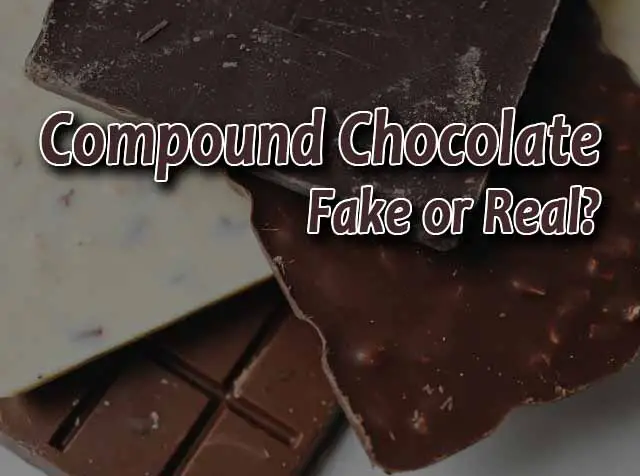If you need a versatile form of chocolate that can be molded, dipped and sets easily, compound chocolate is the way to go.
Compound chocolate is a substitute confectionery ingredient that contains vegetable fats to replace cocoa butter. It is a cheaper chocolate-tasting version of chocolate. You could say it is like imitation crab in the seafood world which is starch and ground-up white fish.
There are other names for compound chocolate such as:
- Compound coating
- Chocolate coating
- Candy coating
The main difference between true and compound chocolate is the ratio of cocoa butter. Compound chocolate uses added hydrogenated vegetable oil instead of cocoa butter. Hydrogenation turns vegetable fats solid at room temperatures (an important feature in chocolate!).
If you want to know exactly what’s in compound chocolate, the difference between true and compound chocolate, and the best ways to use compound chocolate, keep on reading!
What’s Inside Compound Chocolate?
Compound chocolates are usually made from a blend of certain vegetable fats, cocoa powder, and sweetening agents.
Some compound chocolates use emulsifiers to hold the ingredients together in a stable emulsion. Emulsifiers allow the chocolate to flow more freely. This means a better mouthfeel with less grit. Emulsifiers also help reduce the chances of blooming (sugar or fat crystallizing on the surface) in chocolate.
Instead of chocolate liquor and cocoa butter used in actual chocolate, compound chocolate uses cocoa powder and vegetable fats.
This type of chocolate uses vegetable fats that are semi-solid at room temperature. The fats are also added in a ratio to mimic the characteristics of cocoa butter.
Sources of vegetable fats:
- Coconut oil
- Soy bean oil
- Palm kernel oil
- Shea oil
- Mango kernal fat
Is Compound Chocolate Fake?
Compound chocolate is a chocolate substitute that is flexible and allows easier manipulation. It’s a common replacement for true chocolate because it is much cheaper and easier to work with. Other vegetable fats and flavorings have replaced the cocoa butter found in real chocolate.
This difference is comparable to real dairy butter and margarine. Butter is made from milk and cream without extra oil added. Vegetable oil is the source of fat in margarine.
While compound chocolate is not comparable to true chocolate in terms of taste and mouthfeel, there is a big difference between low and high-quality compounds.
This form of “fake chocolate” is really just a compound chocolate-flavored candy coating with some cocoa powder, vegetable fat, and sugar to make up for the lack of cocoa butter.
Difference Between Compound Chocolate and Real Chocolate
Compound chocolate typically has a lower cocoa butter content than “actual” chocolate. Real chocolate does not have extra vegetable oil added; its only source of fat is cocoa butter.
Compound chocolate does not need to be tempered compared to actual chocolate. Compound chocolate sets fine without tempering but does not have the same snap and shine tempered chocolate has. Essentially, it is an easier way to coat something in chocolate.
Tempering chocolates can be a hassle, especially for beginners. If you need something that will set, dip, or pour into moulds with no trouble, compound chocolate is quite easy to handle.
Weight for weight, compound chocolate is relatively cheaper. This is because some other vegetable fat has replaced the expensive cocoa butter in real chocolate. This affects the richness, flavor, and overall mouthfeel of the chocolate. Essentially, you are giving up better taste and texture for a lower price point.
Tastewise, cocoa butter is what gives actual chocolate its rich, smooth texture. In compound chocolate, the lack of cocoa butter is replaced by other vegetable fats and sugar. This added sweetness dulls the natural chocolate flavor found in cacao beans. Low-grade compound chocolates can even have a grittiness to them.
The replacement vegetable fats in compound chocolate have been ratioed to mimic the melting characteristics of true chocolate. This may contribute to how well compound chocolate sets and harden at room temperatures. Note that low-quality compound chocolates will often taste greasy.
Compared to unsweetened or dark chocolate, compound chocolate is sweeter. If you plan to use compound chocolate as a substitute for these kinds of chocolate in a recipe, be sure to reduce the amount of sugar you might add. Compound chocolate contains more sugar than actual chocolate.
In terms of mouthfeel, true chocolate melts on the tongue, whereas compound chocolate takes a bit of a chew and time before it starts to melt.
To compare the melting points of the fats used in chocolate, cocoa butter melts at around 93°F (close to body temperature). This allows the chocolate to be solid at room temperatures but also melts inside the mouth.
What Can You Use Compound Chocolate For?
Compound chocolate is best used for dipping and coating. This is because the chocolate sets without tempering and makes a shell (ideal for soft goods like cake). Have some pretzels or crackers?
Tempering chocolate for that hard snap and shine requires some technical skills to get it right. While you won’t get that in compound chocolate, it will still set and harden.
It sets easily in molds. When trying to make different shapes and designs, melting and pouring the chocolate into molds is hassle-free compared to real chocolate.
Compound chocolate is used as a baking chocolate where the chocolate flavor isn’t the focal point. If the chocolate does not taste great, using it as decor or garnishing is fine. With high-quality compound chocolate, it makes for a nice ganache which is essentially icing.
Some low-grade compound chocolates can taste greasy or have a weird mouthfeel which is why I recommend not using it for baking treats like brownies. Using it like chips and chunks in cookies is a common way to use compound chocolates.
Specialty-made compound chocolates are made for sculpting purposes and are not really meant for consumption.
Can You Mix Chocolate and Compound Chocolate Together?
You could, but then the question becomes why the heck are you doing that? Taking low-quality compound chocolate and mixing it with true or couverture chocolate kind of defeats the purpose of each kind of chocolate.
Compound chocolate is known for its low-price point yet provides a chocolate-like experience. Adding higher quality chocolate just turns it into expensive compound chocolate.


![How to Coat Gummy Candy in Sugar [Without Melting]](https://candyturf.com/wp-content/uploads/2022/10/how-to-coat-gummy-candy.jpg)
